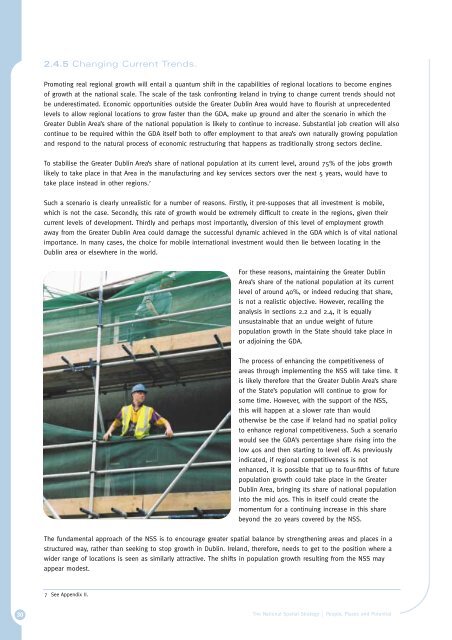National Spatial Strategy For Ireland 2002 - 2020 - Full ... - Kildare.ie
National Spatial Strategy For Ireland 2002 - 2020 - Full ... - Kildare.ie
National Spatial Strategy For Ireland 2002 - 2020 - Full ... - Kildare.ie
Create successful ePaper yourself
Turn your PDF publications into a flip-book with our unique Google optimized e-Paper software.
30<br />
2.4.5 Changing Current Trends.<br />
Promoting real regional growth will entail a quantum shift in the capabilit<strong>ie</strong>s of regional locations to become engines<br />
of growth at the national scale. The scale of the task confronting <strong>Ireland</strong> in trying to change current trends should not<br />
be underestimated. Economic opportunit<strong>ie</strong>s outside the Greater Dublin Area would have to flourish at unprecedented<br />
levels to allow regional locations to grow faster than the GDA, make up ground and alter the scenario in which the<br />
Greater Dublin Area’s share of the national population is likely to continue to increase. Substantial job creation will also<br />
continue to be required within the GDA itself both to offer employment to that area’s own naturally growing population<br />
and respond to the natural process of economic restructuring that happens as traditionally strong sectors decline.<br />
To stabilise the Greater Dublin Area’s share of national population at its current level, around 75% of the jobs growth<br />
likely to take place in that Area in the manufacturing and key services sectors over the next 5 years, would have to<br />
take place instead in other regions. 7<br />
Such a scenario is clearly unrealistic for a number of reasons. Firstly, it pre-supposes that all investment is mobile,<br />
which is not the case. Secondly, this rate of growth would be extremely difficult to create in the regions, given their<br />
current levels of development. Thirdly and perhaps most importantly, diversion of this level of employment growth<br />
away from the Greater Dublin Area could damage the successful dynamic ach<strong>ie</strong>ved in the GDA which is of vital national<br />
importance. In many cases, the choice for mobile international investment would then l<strong>ie</strong> between locating in the<br />
Dublin area or elsewhere in the world.<br />
<strong>For</strong> these reasons, maintaining the Greater Dublin<br />
Area’s share of the national population at its current<br />
level of around 40%, or indeed reducing that share,<br />
is not a realistic objective. However, recalling the<br />
analysis in sections 2.2 and 2.4, it is equally<br />
unsustainable that an undue weight of future<br />
population growth in the State should take place in<br />
or adjoining the GDA.<br />
The process of enhancing the competitiveness of<br />
areas through implementing the NSS will take time. It<br />
is likely therefore that the Greater Dublin Area’s share<br />
of the State’s population will continue to grow for<br />
some time. However, with the support of the NSS,<br />
this will happen at a slower rate than would<br />
otherwise be the case if <strong>Ireland</strong> had no spatial policy<br />
to enhance regional competitiveness. Such a scenario<br />
would see the GDA’s percentage share rising into the<br />
low 40s and then starting to level off. As previously<br />
indicated, if regional competitiveness is not<br />
enhanced, it is possible that up to four-fifths of future<br />
population growth could take place in the Greater<br />
Dublin Area, bringing its share of national population<br />
into the mid 40s. This in itself could create the<br />
momentum for a continuing increase in this share<br />
beyond the 20 years covered by the NSS.<br />
The fundamental approach of the NSS is to encourage greater spatial balance by strengthening areas and places in a<br />
structured way, rather than seeking to stop growth in Dublin. <strong>Ireland</strong>, therefore, needs to get to the position where a<br />
wider range of locations is seen as similarly attractive. The shifts in population growth resulting from the NSS may<br />
appear modest.<br />
7 See Appendix II.<br />
The <strong>National</strong> <strong>Spatial</strong> <strong>Strategy</strong> | People, Places and Potential
















